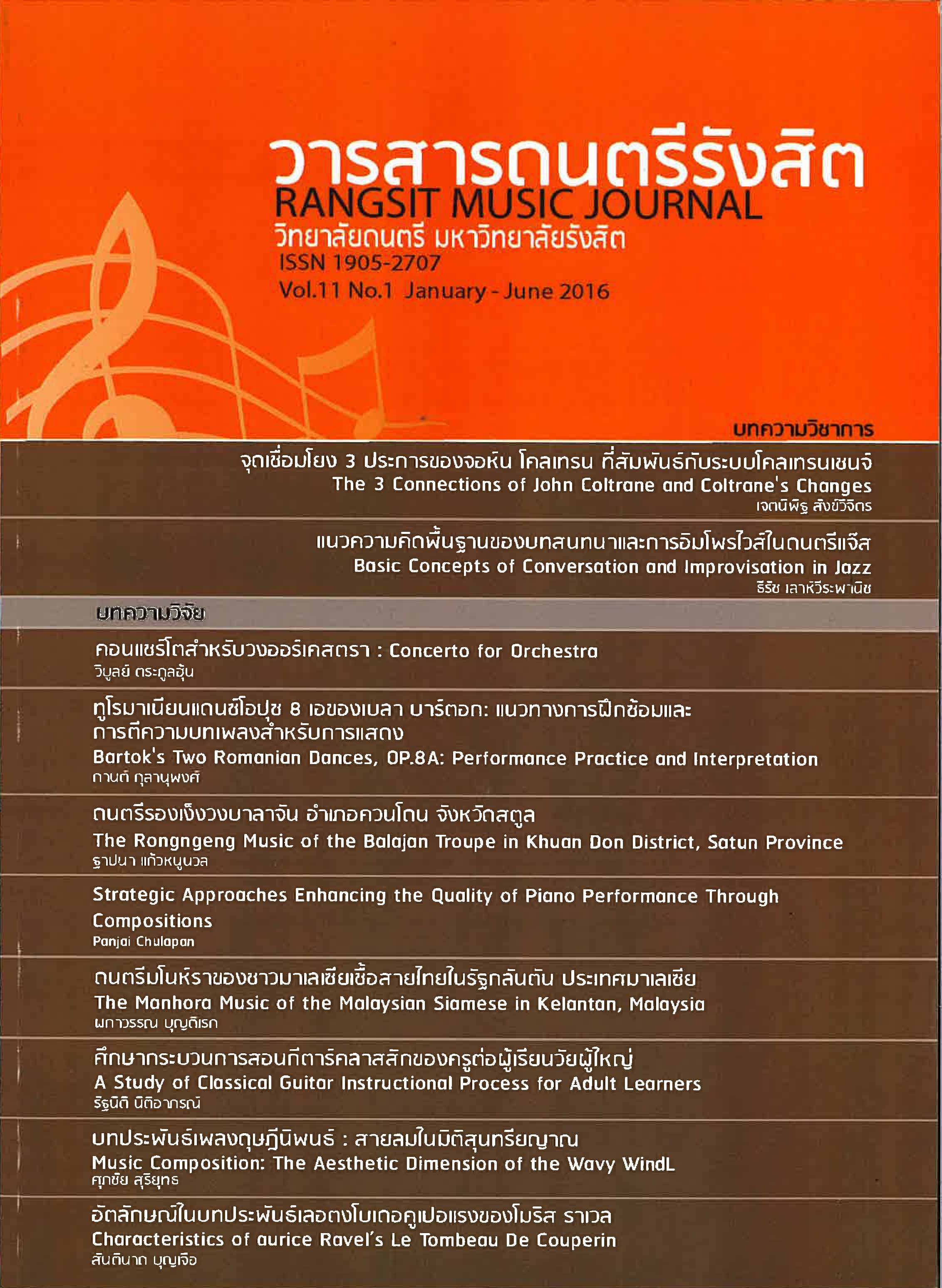บทประพันธ์เพลงดุษฎีนิพนธ์ : สายลมในมิติสุนทรียญาณ
บทคัดย่อ
บทประพันธ์เพลงดุษฎีนิพนธ์สายลมในมิติิสุนทรียญาณ เป็นผลงานการประพันธ์ที่พัฒนาวิธีการที่ได้รับแรงบันดาลใจจากภาพวาดชุดสายลมในมิติสุนทรียญาณ โดยนำสุนทรียศาสตร์และบทกวีมาสร้างงานประพันธ์เพลงบทประพันธ์ ได้ใช้ดนตรีอีสานร่วมกับดนตรีตะวันตกและบรรเลงโดยวงออร์เคสตรา (Orchestra) ประกอบด้วย 3 ท่อน ความยาวรวมทั้งสิ้นประมาณ 30 นาที การประพันธ์เพลงสายลมในมิติสุนทรียญาณ คือ กระบวนการทำงานร่วมกันระหว่างดนตรี ภาพวาดและบทกวี โดยใช้สุนทรียศาสตร์และองค์ประกอบศิลป์ร่วมกัน บทประพันธ์นี้แสดงให้เห็นการผสมผสานและการจัดสีสันเสียงของดนตรีแบบไบโทนาลิตี (Bitonality) การใช้โมดผสมกับบันไดเสียงเพนทาโทนิก และใช้การประสานเสียงในแบบผสมผสาน องค์ประกอบที่ใช้ในการประพันธ์คือ การดำเนินโมทีฟ และการใช้คอร์ดตามโครงสร้างกลุ่มโมทีฟ การใช้คอร์ดเรียงคู่ 4 และ 5 ใช้โพลีโฟนี (Polyphony) การเลียนและการซ้ำทำนอง การขยาย (Augmentation) และย่อส่วนจังหวะ (Diminution) การใช้จังหวะขัด (Syncopation) การซ้อนแนวทำนอง (Stratification) การกระชั้นทำนอง (Compression) การพัฒนาทำนองย่อย (Fragmentation) การแปรทำนอง (Motivic Development) การสร้างแนวทำนองรอง (Countermelody) โน้ตเสียงค้าง (Pedal Point) การสร้างขั้นคู่เพอร์เฟคขนาน (Parallel Perfect Interval) เป็นต้น บทประพันธ์เพลงดุษฎีนิพนธ์สายลมในมิติสุนทรียญาณ เป็นดนตรีร่วมสมัยที่ผสมผสาน ระหว่างดนตรีตะวันออก และดนตรีตะวันตก รวมทั้งยังได้อิทธิพลจากภาพวาดและดนตรีพื้นบ้าน สร้างความสอดคล้องกันในมิติของจินตนาการที่นำมาประยกุต์ร่วมกัน
เอกสารอ้างอิง
2.______. หมอลำ-หมอแคนคู่มือการเป่าแคนเบื้องต้นดนตรีพื้นบ้านอีสานแคนวงและโปงลางลายแคน หรือบันไดเสียงของแคนในเคล็ดลับการสร้างสรรค์ทำนองลำ. มหาสารคราม: วิทยาลัยครูมหาสารคาม มหาวิทยาลัยศรีนครินทรวิโรฒ, 2518.
3. รัฐธนินท์ รวีฉัตรพงษ์. "เดี่ยวแคน ทางครูบัวหอง ผาจวง." วิทยานิพนธ์ศิลปศาสตร์มหาบัณฑิต, จุฬาลงกรณ์มหาวิทยาลัย, 2554.
4. สนอง คลังพระศรี. "ระบบเสียงแคนและทฤษฎีการบรรเลงแคน." วิทยานิพนธ์ปรัชญาดุษฎีบัณฑิต, มหาวิทยาลัยมหิดล, 2554.
5. ณรงค์ฤทธิ์ ธรรมบุตร. อรรถาธิบายและบทวิเคราะห์เพลงที่ประพันธ์โดย ณรงค์ฤทธิ์ ธรรมบุตร. กรุงเทพฯ: สำนักพิมพ์แห่งจุฬาลงกรณ์มหาวิทยาลัย, 2553.
6. ______. การประพันธ์เพลงร่วมสมัย. กรุงเทพฯ: สำนักพิมพ์แห่งจุฬาลงกรณ์มหาวิทยาลัย, 2552.
7. ณัชชา พันธุ์เจริญ. พจนานุกรมศัพท์ดรุิยางคศิลป์. พิมพ์ครั้งที่ 3. กรุงเทพฯ: เกศกะรัต, 2552.
8. วีรชาติ เปรมานนท์. รายงานผลการวิจัยดนตรีไทยแนวใหม่ช่วงปี พ.ศ. 2520-2530. กรุงเทพฯ: จุฬาลงกรณ์มหาวิทยาลัย, 2532.
9. ________. ปรัชญาและเทคนิคการแต่งเพลงร่วมสมัยไทย. กรุงเทพฯ: จุฬาลงกรณ์มหาวิทยาลัย, 2532.
10. Uno Everett, Yayoi. "Calligraphy and Music Gestures in the Late Works of Chou Wen-chung."Accessed October/December, 2007. https://scholarblogs.emory.edu







